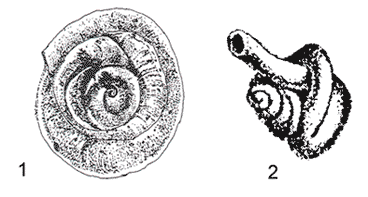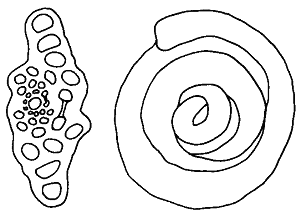
Fig. 25. 1- Lectotype of G. gordialis from the Parker Collection, redrawn from an SEM photograph. 2- earliest figure of G. gordialis, from Carpenter et al. (1862). ORIGINAL DESIGNATION: Trochammina squamata Jones & Parker var. gordialis Jones & Parker, 1860. TYPE REFERENCE: Jones, T.R. & Parker, W.K. 1860. On the Rhizopodal fauna of the Mediterranean compared with that of the Italian and some other Tertiary deposits. Quarterly Journal of the Geological Society of London, 16, 292-307 (no type figure given). The earliest figure was given by Carpenter et al. (1862), pl. 11, fig. 4 (reproduced above). See also: Berggren, W.A., & Kaminski, M.A. 1990. Abyssal Agglutinates: Back to Basics. In: Hemleben, C., Kaminski, M.A., Kuhnt, W., and Scott, D.B., (Eds.), Paleoecology, Biostratigraphy, Paleoceanography and Taxonomy of Agglutinated Foraminifera, NATO ASI Series C-327, Kluwer Acad. Publ. 53-76. pl. 1, fig. 1 [Lectotype]. TYPE SPECIMEN: Deposited in the micropaleontological collections of the British Museum (Natural History). In his manuscript catalog of the W.K. Parker Collection, T.R. Jones identified two slides containing "Ammodiscus gordialis". The samples which yielded these specimens were collected in 1859, therefore, the specimens are syntypes. The lectotype (ZF 4876) designated by Berggren & Kaminski (1990) and given here (pl. 25, fig. 1), is from Slide 1894.4.3.540. Metatypes are housed in Slide 1894.4.5.709. TYPE LEVEL: Recent. TYPE LOCALITY: not originally designated. In the original description, Jones & Parker (1860) reported this taxon from the Indian Ocean and Arctic seas. No locality was specified for the specimen illustrated by Carpenter et al. (1862), and we did not find this specimen in the W.K. Parker Collection. The specimens in the W.K. Parker Collection are from two stations in the Mediterranean. The lectotype specimen is from the H.M.S. Firebrand dredge sample collected off Gozo Island, Malta (see type locality of G. charoides). The other sample is from a dredging collected by Capt. J.A.B. Spratt in 170 fathoms off Serpho Island in the Greek Archipelago. DIAGNOSTIC FEATURES: Test comprised of a globular proloculus followed by an undivided tubular second chamber that is at initially coiled in a high trochospiral manner about the proloculus, forming a single layer of coils that completely envelop the proloculus as in G. charoides, later coiled glomospirally about a common plane, usually in 5 or 6 whorls. Coiling in the glomospiral portion of the test is open, not enrolled, and the umbilical region is usually visible and is depressed. The terminal part of the tube may be coiled somewhat irregularly. Wall imperforate, finely agglutinated, with undifferentiated organic cement and an inner and outer organic lining, smoothly finished. Aperture at the open end of the tube. Modern specimens are light brown in color. SIZE: Diameter of lectotype: 28 mm along major axis, 30 mm along minor axis. Diameter of tube in the last whorl: 60 microns. Paralectotypes are 25 - 37 mm along the major axis. Cushman (1918) reported specimens up to 90 mm in diameter. SYNONYMS: None verified. OBSERVED OCCURRENCES: Glomospira gordialis has been reported from Cretaceous to Recent deep-water sediments from throughout the world ocean. In the modern deep ocean it is the dominant species of Glomospira. It is widely distributed, but usually occurs in low numbers. Brady (1884) reported this species from 27 CHALLENGER stations ranging in depth from 50 to over 2,000 fathoms, and noted that it was also present in the polar stations. Cushman (1918) recorded it from 10 ALBATROSS stations in the North Atlantic from 167 to 1608 fathoms. In the Southern Ocean, Earland (1934) reported it to be widely distributed from 262 to 4845 m, but most common at deeper stations. Lukina (1980) observed it between 3095 and 7560 m in the central Pacific (Hawaii, Gilbert & Marshall Islands, and the Tonga Trench). Glomospira gordialis occurs in low abundance on the Newfoundland and Nova Scotian continental slopes (Cole, 1981; Schröder, 1986), but is the only species of Glomospira present in our samples from the Nares and Hatteras abyssal plains. Jonasson et al. (1995) reported increased abundance of G. gordialis in sulphide-containing "hydrothermal muds" in the proximity of active hydrothermal vents in the Juan de Fuca Ridge. It is also a component of the lower Campanian and lower Eocene "Glomospira facies" in the North Atlantic and Western Tethys. KNOWN STRATIGRAPHIC RANGE: Late Cretaceous to Recent. BATHYMETRY: Bathyal to abyssal. Cushman (1918) reported it from stations as shallow as 167 fathoms in the North Atlantic. Pflum & Frerichs (1976) listed its upper depth limit at around 400 m in the Gulf of Mexico. REMARKS: Glomospira gordialis is today regarded as one of the best known species of agglutinated foraminifera. It has been cited by more authors than we would care to count. However, when the detailed history of this taxon is closely examined, one is confronted with the author's changing taxonomic concepts, the lack of designated types, and a misleading original illustration by Carpenter et al. (1862), which has led to the imprecise definition of the genus Glomospira by Loeblich & Tappan (1987). Because Carpenter's figure does not conform to the modern concept of the species, and because T. squamata var. gordialis is the type species of Glomospira, it is necessary to carefully review the authors' original species concepts. Jones & Parker (1860) described Trochammina squamata var. gordialis as follows: "Trochammina squamata comprises five varieties which are spiral, and more or less Rotalian in their growth. (...) The third variety, Trochammina squamata gordialis (from the Indian and Arctic Sea), has more than one chamber, the shell at the early stage being formed of a few spirally arranged but variable chambers; and at a later period being moulded on an undivided, vermiform sarcode, either discoidal or irregularly elevated; sometimes passing at nearly right angles over the disc, or forming sudden loops or twistings." The name "gordialis" was chosen by Jones & Parker with reference to the "Gordian knot" of ancient history. This was tied by Gordius, King of Phrygia, who declared that whoever untied the knot should be master of all of Asia. Apparently, Jones & Parker had observed a specimen that coiled irregularly in its later stage. Unfortunately, the authors did not specify a type locality or provide a figure for T. squamata var. gordialis, and the first illustration of the form was not published until two years later by Carpenter et al. (1862). Carpenter's textbook on Foraminifera was written with the help of Jones & Parker, who probably aided Carpenter with the species descriptions. Just two years after the publication of its original description, the variety T. squamata gordialis had already been raised to species status. The description of T. gordialis, however, was emended slightly (assumedly by the original authors), and differed from the original description in one key point (emphasis ours): "In T. gordialis, the tube presents in its early convolutions an irregular division into chambers; in its later portion, however, is undivided, and may either continue to coil in its original plane or may raise itself from this and pass over the earlier portion, forming loops and twistings in various directions, resembling those of a Gordius. " The change in the description is subtle, but the authors omitted the expression "vermiform sarcode" which brings to mind the image of something quite irregular. It appears that Carpenter, Parker & Jones now had in mind a form which may be regularly coiled or irregular. In fact later in life, T. Rupert Jones refered this species to the genus Ammodiscus, which suggests that his own taxonomic concepts were evolving through time and his mind, T. squamata gordialis was becoming more regular. It is the more regularly coiled form which best fits the modern concept of G. gordialis. "Proloculus followed by undivided tubular second chamber that is streptospirally coiled to somewhat irregular; wall finely agglutinated; aperture at the open end of the tube." 
Fig. 25-2. Cross section through Glomospira gordialis, revealing the high trochospiral initial coiling, redrawn after Bender (1995) ILLUSTRATIONS: Plate 25 - Glomospira gordialis (Jones & Parker) Fig. 1. Recent, Mediterranean, Lectotype from the Parker Collection (BMNH Slide no ZF 4876, ex Slide 1894.4.3.540); Fig. 2a,b. Recent, Mediterranean, Paralectotype from the Parker Collection, (BMNH Slide no. ZF 4877, ex Slide 1894.4.3.709); Fig. 3. Recent, Hatteras Abyssal Plain; Fig. 4. Recent, Hatteras Abyssal Plain; Fig. 5-6. Late Miocene, ODP Site 646, Labrador Sea, Sample 646A-77R-5, 25-27 cm; Fig. 7-8. Early Eocene, ODP Site 647, Labrador Sea, Sample 647A-65R-1, 31-34 cm. 
|